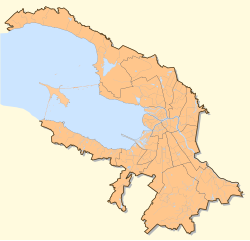Lomonosov, Russia
Lomonosov
Ломоносов | |
|---|---|
 Lomonosov Museum of Local History | |
| Coordinates: 59°55′N 29°46′E / 59.917°N 29.767°E | |
| Country | Russia |
| Federal subject | Saint Petersburg |
| Founded | 1710 |
| Population | |
• Total | 42,505 |
| Time zone | UTC+3 (MSK |
| Postal code(s)[3] | |
| Dialing code(s) | +7 812 |
| OKTMO ID | 40372000 |
| Website | web |


Lomonosov (Russian: Ломоно́сов; before 1948: Oranienbaum, Ораниенба́ум) is a municipal town in Petrodvortsovy District of the federal city of Saint Petersburg, Russia, located on the southern coast of the Gulf of Finland, 40 kilometers (25 mi) west of Saint Petersburg proper. Population: 42,505 (2010 Census);[1] 37,776 (2002 Census).[4] Lomonosov is the site of the 18th-century royal Oranienbaum park and palace complex, notable as being the only palace in the vicinity of Saint Petersburg that was not captured by Nazi Germany during World War II.
History
[edit]Oranienbaum was granted town status in 1710, and was initially applied to the Oranienbaum palace complex, built between 1710 and 1725 opposite Kronstadt, in the neighbourhood of the royal residence Peterhof Palace, by the architects Giovanni Mario Fontana and Gottfried Johann Schadel, and was intended for Alexander Menshikov, a close associate of Peter the Great. The original name of the town translates to "orange tree" in German (in modern German, the word is Orangenbaum), and is believed to have been derived from the palace complex which had greenhouses to grow exotic plants such as orange trees. According to another version, the name means “Tree of Orange” in honour of William III of Orange, stadtholder of the Netherlands and king of England, who was the idol of Peter the Great, or it was borrowed from the toponymy of Germany (the city of Oranienbaum in the Principality of Anhalt named by Princess Henrietta Katharina Nassau-Oransky after her home place) simply as a “beautiful” name in the fashion spirit of the Petrine era.
During World War II the town was heavily involved in the Siege of Leningrad, where Red Army forces managed to establish a foothold at Oranienbaum, in the rear of the forces of Nazi Germany. This foothold had a major importance in the launching of the Leningrad–Novgorod Offensive in early 1944, which finally ended the siege (see Leningrad–Novgorod Offensive). In 1948, the town was renamed to its current name Lomonosov, in honor of the scientist, poet and glassblower Mikhail Lomonosov. In 1754, Lomonosov had founded a colored-glass factory near Oranienbaum, in the village of Ust-Ruditsa. An unofficial nickname, Rambov, a Russified contraction of the old name Oranienbaum, is popular among the local residents.
Lomonosov can be reached by suburban train from St. Petersburg's Baltic Terminal to Oranienbaum Station.
People from Oranienbaum
[edit]- Igor Stravinsky (1882–1971), composer of modern classical music
- Aleksandr Mostovoi, footballer
International relations
[edit]Twin towns and sister cities
[edit]Lomonosov is twinned with:
 Mariehamn, Åland, Finland
Mariehamn, Åland, Finland Framingham, Massachusetts, United States
Framingham, Massachusetts, United States Anacortes, Washington, United States
Anacortes, Washington, United States Oberursel (Taunus), Hesse, Germany (suspended in 2022)[5]
Oberursel (Taunus), Hesse, Germany (suspended in 2022)[5]
Gallery
[edit]-
Coat of arms of Lomonosov (Oranienbaum)-1780
-
City gate of Lomonosov
-
Kammenoye pavilion at the palace complex of Oranienbaum
-
Grand Menshikov Palace
-
Grand Menshikov Palace
-
Grand Menshikov Palace
See also
[edit]References
[edit]- ^ a b Russian Federal State Statistics Service (2011). Всероссийская перепись населения 2010 года. Том 1 [2010 All-Russian Population Census, vol. 1]. Всероссийская перепись населения 2010 года [2010 All-Russia Population Census] (in Russian). Federal State Statistics Service.
- ^ "Об исчислении времени". Официальный интернет-портал правовой информации (in Russian). June 3, 2011. Retrieved January 19, 2019.
- ^ Почта России. Информационно-вычислительный центр ОАСУ РПО. (Russian Post). Поиск объектов почтовой связи (Postal Objects Search) (in Russian)
- ^ Federal State Statistics Service (May 21, 2004). Численность населения России, субъектов Российской Федерации в составе федеральных округов, районов, городских поселений, сельских населённых пунктов – районных центров и сельских населённых пунктов с населением 3 тысячи и более человек [Population of Russia, Its Federal Districts, Federal Subjects, Districts, Urban Localities, Rural Localities—Administrative Centers, and Rural Localities with Population of Over 3,000] (XLS). Всероссийская перепись населения 2002 года [All-Russia Population Census of 2002] (in Russian).
- ^ "Städtepartnerschaft mit Lomonossow soll ruhen". March 4, 2022. Retrieved October 25, 2023.
External links
[edit]












